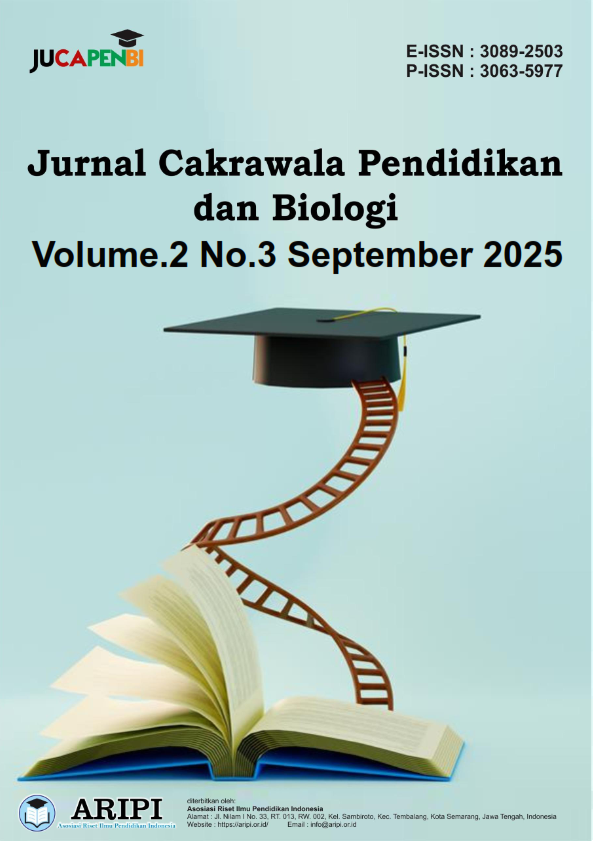Pengembangan Video Animasi Berbasis Canva pada Materi Makanan dan Sistem Pencernaan Makanan Kelas XI SMA/MA
DOI:
https://doi.org/10.61132/jucapenbi.v2i3.670Keywords:
animated video, Canva, Development, human digestive system, PlompAbstract
This preliminary study was conducted as the foundation for developing an animated video-based learning media using Canva. The main objective of this research is to present the initial data collected during the early investigation phase, which will serve as the basis for creating innovative, research-based learning media in the future. The development model applied in this research is the Plomp model, and the study has currently reached the preliminary investigation stage. Data were collected using several instruments, including interviews, classroom observations, and student needs assessment questionnaires. The results of the needs assessment revealed that the learning media currently used in schools is considered less effective, leading to difficulties for students in understanding the subject matter. Furthermore, 91.33% of students agreed that the development of an animated video-based learning media using Canva would be beneficial and support the learning process. These findings indicate a strong need for engaging, interactive, and technology-integrated learning media. The selected topic for development is “Food and the Digestive System,” which is part of the curriculum for grade XI students in senior high schools (SMA/MA), as this topic is often perceived as challenging. By utilizing Canva to create animated videos, it is expected that students’ learning motivation, conceptual understanding, and classroom engagement will significantly improve. The results of this preliminary study serve as an essential foundation for the next stages of development, ensuring that the final product will provide an effective and enjoyable learning experience tailored to students’ needs.
References
Ahmad, S., Umirzakova, S., Mujtaba, G., Amin, M. S., & Whangbo, T. (2023). Education 5.0: Requirements, enabling technologies, and future directions. arXiv preprint. https://arxiv.org/abs/2307.15846
Aris, A. A., Pebriana, P. H., Judijanto, L., Ramadhona, R., Lestari, N. C., & Maq, M. M. (2024). The role of technology to enhance learning awareness in schools: Literature review. Dharmas Education Journal (DE_Journal), 5(1), 449–554. https://doi.org/10.56667/dejournal.v5i1.1308
Arsyad, M., Fitroh, I., & Arifin, M. S. (2023). Transforming 21st century education: Analysing the implementation of technology in teaching and learning. Jurnal Ilmiah Edukatif, 10(2). https://doi.org/10.37567/jie.v10i2.3423
Asnawati, Y., & Sutiah, S. (2023). Pengembangan media vidio animasi berbasis aplikasi Canva untuk meningkatkan motivasi belajar siswa. Journal of Islamic Education, 9(1), 64–72. https://doi.org/10.18860/jie.v9i1.22809
Hasan, M., Milawati, Darodjat, Khairani, H., & Tahrim, T. (2021). Media pembelajaran. Tahta Media Group.
Hikmah, V. N., & Purnamasari, I. (2017). Pengembangan video animasi “Bang Dasi” berbasis aplikasi. Mimbar Sekolah Dasar, 4(2), 182–191. https://doi.org/10.23819/mimbar-sd.v4i2.6352
Jannah, M. M., & Rasyid, H. (2023). Kurikulum Merdeka: Persepsi guru pendidikan anak usia dini. Jurnal Obsesi: Jurnal Pendidikan Anak Usia Dini, 7(1), 197–210. https://doi.org/10.31004/obsesi.v7i1.3800
King, R., Wilson, L., & Slama, F. B. (2025). Impact of educational technology on student well-being: An Australian perspective. Journal Emerging Technologies in Education, 3(1), 12–22. https://doi.org/10.70177/jete.v3i1.2109
Majid, M. Z. A., Norman, M. H., Zaini, M. H., Zulnaidi, H., & Nasir, M. K. M. (2025). Technological empowerment in education: A systematic review. SAGE Open, 15(3). https://doi.org/10.1177/21582440251325077
Mutiara, M., & Hidayati, N. (2023). Pengembangan media pembelajaran IPA berbasis video animasi menggunakan aplikasi Powtoon materi energi dalam kehidupan sehari-hari. Jurnal Arjuna: Publikasi Ilmu Pendidikan, 1(4). https://doi.org/10.61132/arjuna.v1i4.109
Naimawati, I., Widoyoko, R. D. T., & Mukodi, M. (2023). Register pada akun menfess penggemar Korea di Twitter (Studi kajian sosiolinguistik). Jurnal Bahasa dan Sastra, 10(2). https://doi.org/10.60155/jbs.v10i2.328
Ng, W., et al. (2023). Educational transformation through emerging technologies: Critical review of scientific impact on learning. Education Sciences, 15(3), 368. https://doi.org/10.3390/educsci15030368
Permatasari, D., Wahyuni, N. A., & Andikos, A. F. (2024). The technology-based learning models: Building 21st century skills in early childhood. TOFEDU: The Future of Education Journal, 3(5), 1216–1222. https://doi.org/10.61445/tofedu.v3i5.215
Rahmayanti, L., & Istianah, F. (2018). Pengaruh penggunaan media video animasi terhadap hasil belajar siswa kelas V SDN se-Gugus Sukodono Sidoarjo. State University of Surabaya.
Sutriani, E., & Octaviani, R. (2019). Topik: Analisis data dan pengecekan keabsahan data. INA-Rxiv, 1–22. https://doi.org/10.31227/osf.io/3w6qs
Syahrizal, H., & Jailani, M. S. (2023). Jenis-jenis penelitian dalam penelitian kuantitatif dan kualitatif. QOSIM: Jurnal Pendidikan Sosial & Humaniora, 1(1), 13–23. https://doi.org/10.61104/jq.v1i1.49
Downloads
Published
How to Cite
Issue
Section
License
Copyright (c) 2025 Jurnal Cakrawala Pendidikan dan Biologi

This work is licensed under a Creative Commons Attribution-ShareAlike 4.0 International License.






